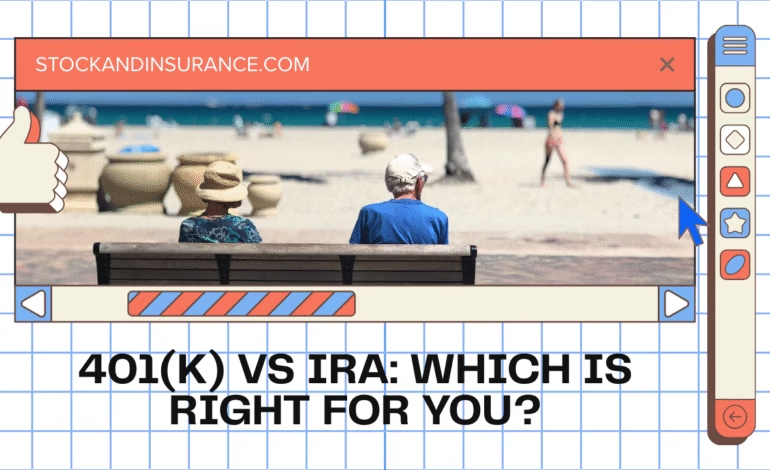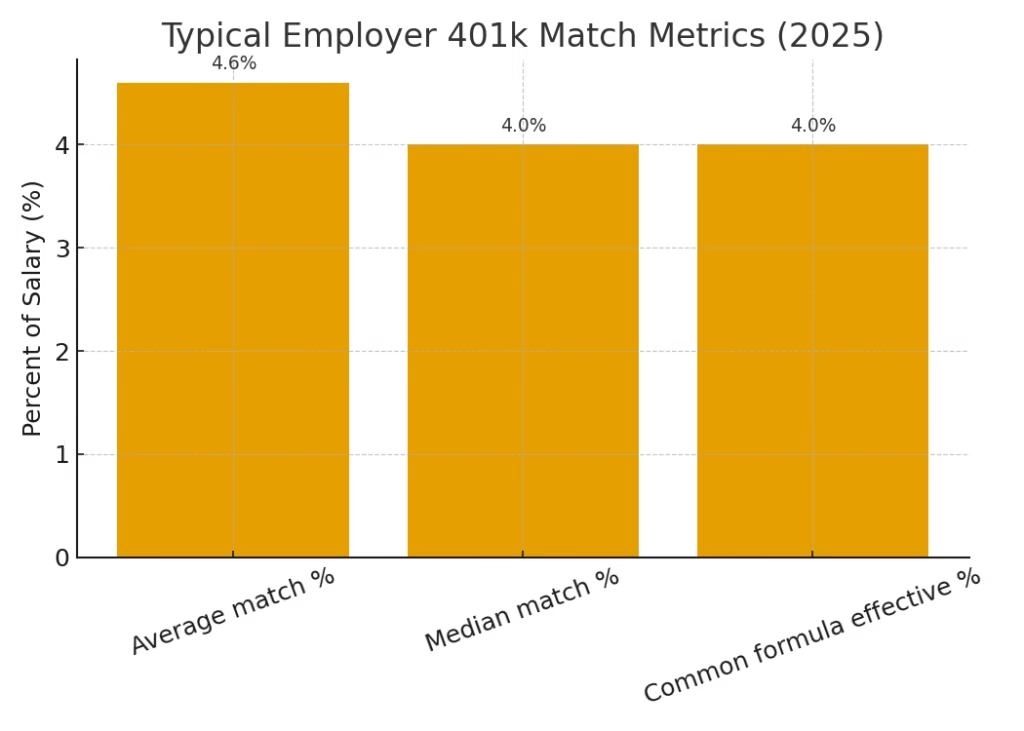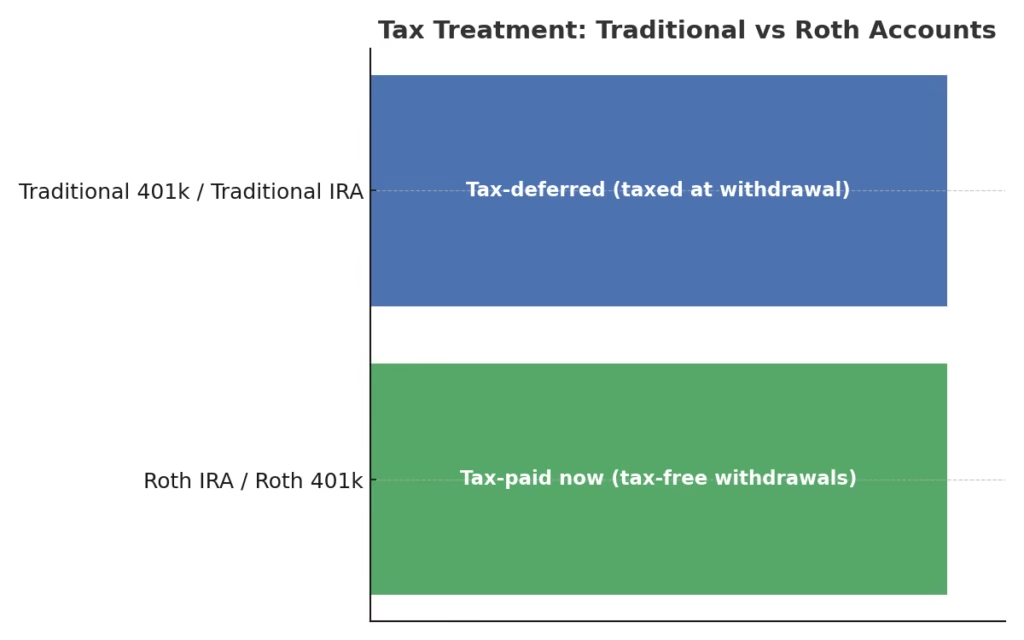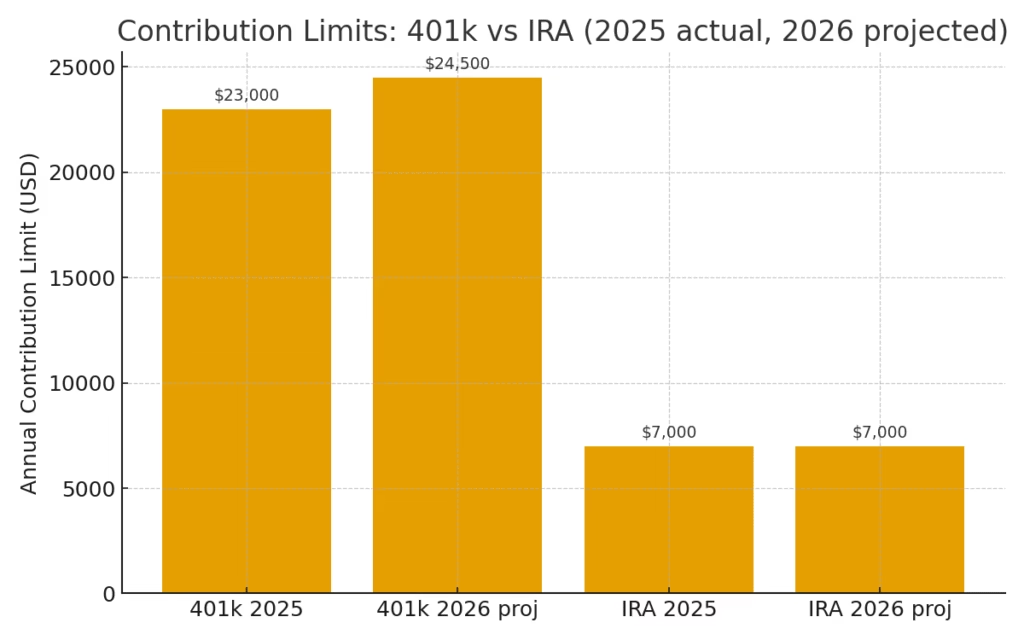
When it comes to planning for retirement, one of the most common questions people ask is simple yet powerful: 401 k vs IRA which is right for me?
If you are working in the United States or any countries like Canada, UK, or Singapore, you have probably come across terms like Roth IRA vs 401k, difference between IRA and 401k, or even asked yourself what is a Roth IRA vs 401k. The truth is, both are excellent retirement savings tools, but which one you choose, or how you combine them, could dramatically change your financial future.
In this guide, I will break down the differences between Roth IRA and 401k, the benefits, drawbacks, and real-world examples to make sure you do not just pick randomly but actually make the best decision for your retirement strategy.
What is a 401 k?
A 401 k is an employer-sponsored retirement savings plan. If you are employed full-time, your company may allow you to contribute a portion of your paycheck directly into a 401 k account before taxes are taken out.
Key points to know about a 401 k:
- Contributions reduce your taxable income today.
- Many companies match a percentage of your contributions which is essentially free money.
- Contribution limit in 2026 is estimated to be around 23,000 dollars annually, with higher limits for people over 50 who qualify for catch-up contributions.
Example: Suppose you earn 70,000 dollars a year. If you contribute 10,000 dollars to your 401(k), your taxable income drops to 60,000 dollars. That means less tax today while your savings grow for tomorrow.

What is an IRA?
An Individual Retirement Account, also called an IRA, is a retirement savings account you open on your own and not through your employer. Anyone with earned income can open one.
If you are based in Canada or the UK, you may also want to explore our breakdown of Top Retirement Savings Plans in the UK and Canada.
There are two main types of IRAs:
- Traditional IRA: Contributions may be tax-deductible today, but withdrawals in retirement are taxed.
- Roth IRA: Contributions are not tax-deductible today, but withdrawals in retirement are tax-free.
The contribution limit in 2026 is estimated to be around 7,000 dollars annually, or 8,000 dollars if you are over 50.
Example: Imagine Maria, a freelancer earning 80,000 dollars a year. Since she does not have an employer-sponsored 401 k, she puts 6,000 dollars into a Roth IRA. She pays taxes now, but in retirement, she withdraws that money completely tax-free.
The Big Question: 401 k or IRA?
Now that you know the basics, here comes the critical question: 401 k or IRA, which one is better for you?
The short answer is that it depends on your income, employer benefits, and retirement goals.
If your employer offers a 401 k with a match, you should almost always start there. The reason is simple. That employer match is free money that adds up to a significant amount over time.
If you do not have a 401 k, or you want more investment flexibility, a Roth IRA might be the smarter move.
Why This Decision Matters in 2026 and Beyond
Retirement rules are evolving. Tax laws may change, contribution limits rise, and market conditions fluctuate. For high-net-worth individuals, combining both accounts is often the best diversification strategy. I have also explained this in detail in my article on High Net Worth Individuals Diversify Their Portfolios in 2026 which explores how wealthy investors balance both tax-deferred and tax-free growth.
That is why understanding the difference between Roth IRA and 401k today is not just about saving for retirement. It is about building wealth in the smartest possible way.
Detailed Comparison of 401 k vs IRA
When you compare a 401k to an IRA, the differences become clearer once you look at how each plan works in terms of contribution limits, taxes, investment choices, and withdrawals. Let us walk through these side by side.
Contribution Limits
A major difference between IRA and 401k is how much you can contribute each year.
- With a 401k, the limit in 2026 is expected to be around 24,500 dollars per year. If you are over 50, you may be able to add another 7,500 dollars as a catch-up contribution.
- With an IRA, the limit is around 7,000 dollars, or 8,000 dollars if you are 50 or older.
This means if you want to save larger amounts each year, a 401k offers far more room.
Employer Match
The single biggest advantage of a 401k is the employer match. Many companies will match 50 percent of your contribution up to 6 percent of your salary. Some even match dollar for dollar. That is free money you do not want to leave on the table.
For example, if your salary is 60,000 dollars and you contribute 6 percent, that is 3,600 dollars. If your employer matches 50 percent, they add 1,800 dollars. That is 1,800 dollars of extra money growing tax-deferred every year.
Tax Treatment
Here is where things get interesting.
- A traditional 401k and a traditional IRA both let you contribute pre-tax money, lowering your taxable income today. You pay taxes when you withdraw in retirement.
- A Roth IRA, however, flips this. You contribute after-tax dollars today, but you withdraw tax-free later.
- Some employers also offer a Roth 401k option, which works like a Roth IRA but with much higher contribution limits. For the most up-to-date IRS rules on contribution limits, visit the official IRS 401k Resource.
Which is better? If you believe your tax rate in retirement will be higher than today, a Roth is smarter. If you expect to be in a lower tax bracket later, a traditional 401 k or IRA gives you more benefit upfront.

Investment Choices
Another difference between IRA and 401k is flexibility.
- 401k plans often limit you to a menu of mutual funds chosen by your employer. Sometimes the fees are high, and your investment options are limited.
- IRAs give you almost unlimited choices including stocks, bonds, ETFs, index funds, and more. That flexibility can be valuable if you want control over your strategy.
Withdrawals and Penalties
Both accounts are designed for retirement, so the government discourages early withdrawals.
- If you take money out before age 59 and a half, you usually pay a 10 percent penalty plus taxes.
- With IRAs, there are a few exceptions such as using money for your first home or qualified education expenses.
- With 401k accounts, you may be able to take a loan against your balance, but this can be risky if you leave your job before repaying it.
Required Minimum Distributions
Both traditional IRAs and traditional 401ks require you to start taking money out at age 73. These are called Required Minimum Distributions or RMDs. Roth IRAs do not have this requirement, which makes them powerful for estate planning.
Which Option Is Best for You?
If you are just starting out and your employer offers a match, the smart move is to contribute enough to your 401k to get the full match. After that, if you still have money to invest, opening a Roth IRA can give you both tax-deferred and tax-free growth.
If you are self-employed or working freelance without a 401k, then starting with a Roth IRA may be the most beneficial choice.
If you are a high earner looking to maximize savings, you might consider contributing the maximum to your 401k and then also funding an IRA. Some people even use advanced strategies like a backdoor Roth IRA if their income is too high for regular Roth contributions.
Remember, the best retirement strategy is often not either-or but using both accounts in combination.
Real-Life Scenarios: 401 k vs IRA
To make this comparison practical, let’s walk through some real-life cases.
Case 1: Young Professional Starting Out
Emily, age 25, just landed her first full-time job in the US with a salary of 55,000 dollars. Her employer offers a 401k with a 4 percent match.
- If Emily contributes 6 percent of her salary, that is 3,300 dollars a year.
- With her employer match, she gets an extra 2,200 dollars for free.
- She still has room to invest in a Roth IRA for tax-free growth.
Best move: Take full advantage of the 401k match and then contribute to a Roth IRA for flexibility later.
Case 2: Mid-Career Professional With Higher Income
John, age 40, earns 120,000 dollars a year. He wants to maximize retirement contributions.
- He can put 23,000 dollars into his 401k.
- He can also contribute 7,000 dollars into a traditional or Roth IRA if eligible.
- Because of his income, he may not qualify for a direct Roth IRA, but he could explore a backdoor Roth strategy.
Best move: Max out his 401k, grab the employer match, and add an IRA for diversification and tax planning. If you want a deeper dive into IRA rules and tax benefits, this Fidelity IRA Guide is a trusted resource.

Case 3: Freelancer Without Employer Benefits
Sophia, age 35, works as a freelance designer earning 80,000 dollars a year. She has no employer plan.
- She cannot access a traditional 401k.
- She can open a Roth IRA and contribute 7,000 dollars annually.
- If she wants to save more, she can set up a Solo 401k or SEP IRA.
Best move: Start with a Roth IRA for tax-free withdrawals, then consider a Solo 401k if she wants higher contribution limits.
Pros and Cons of Each Option
401k Pros
- Higher contribution limits
- Employer match is free money
- Easy payroll deductions
401k Cons
- Limited investment choices
- Possible high fees
- Early withdrawal penalties
IRA Pros
- Wide range of investment options
- Roth IRA offers tax-free withdrawals
- Flexibility for specific exceptions like education or first home
IRA Cons
- Lower contribution limits
- No employer match
- Income restrictions for Roth IRA
401 k or IRA: The Final Verdict
So, which should you choose between 401 k vs IRA? The answer depends on your situation.
- If you have an employer match, always start with the 401k to capture free money.
- If you want flexibility and tax-free withdrawals, add a Roth IRA.
- If you are self-employed, explore Solo 401k or SEP IRA options.
- If you are a high earner, consider advanced tax planning strategies like a backdoor Roth.
In most cases, the best solution is not one over the other but a smart combination of both.
Quick Quiz for You
Have you started contributing to either a 401 k or IRA yet?
- Yes, I contribute regularly
- I started but paused contributions
- No, I am still researching
Drop your answer in the comments below. You might be surprised to see how many people are in the same stage as you.
Final Thoughts
Retirement planning does not have to be overwhelming. Once you understand the difference between IRA and 401k, you can create a roadmap that balances tax savings today with growth for tomorrow. The sooner you begin, the more time your investments have to compound and secure your future.
If you want to dive deeper into advanced planning strategies, check out related guides on maximizing retirement contributions and high-net-worth portfolio diversification.
Your retirement is not just about reaching a number. It is about freedom, security, and peace of mind. Start today and let your future self thank you tomorrow.



